The type of hull determines what kind of propeller is required to move the boat through the water. There are two basic hull types: displacement and planing. Displacement boats are comparatively slow.
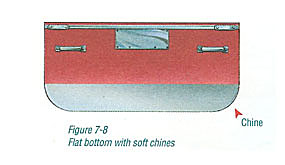

They are supported by the weight of the water they displace (static water pressure). They are generally designed with a somewhat pointed or rounded stern as well as a pointed or rounded bow. They ride low in the water like large ocean-going ships. The propellers on these boats run totally submerged and will generally be of lower pitch, when powered by an outboard or stern drive.
Planing boats, which include most recreational boats, operate like a displacement hull at low speed (below 10 MPH). With sufficient power, these boats rise to the water's surface and operate in a skimming or planing mode, supported primarily by the water's velocity pressure.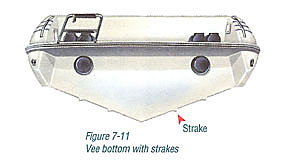
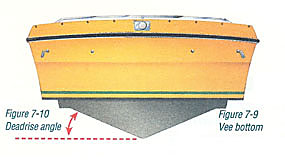 Planing boats are generally faster and more efficient than displacement boats. Their design is distinguished from a displacement design by having a broad transom that meets the bottom with a basically sharp corner. The propellers on these boats often are not fully submerged and thus need to provide holding ability as well as higher pitch and rake because of the higher top-end speeds.
Planing boats are generally faster and more efficient than displacement boats. Their design is distinguished from a displacement design by having a broad transom that meets the bottom with a basically sharp corner. The propellers on these boats often are not fully submerged and thus need to provide holding ability as well as higher pitch and rake because of the higher top-end speeds.
Following is a description of typical hull designs for outboard and stern drive boats.
Flat Bottom
When a boat's bottom has no "v" but is simply flat from side to side, it is generally referred to as a flat bottom. Where the bottom meets the side is called the "chine." It may have squarish corners (called square, sharp, or hard chines) (Figure 7-7) or rounded corners (called round or soft chines) (Figure 7-8).
Vee Bottom

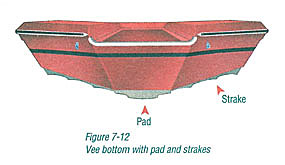 This is presently the most common bottom design (Figure 7-9), offering good speed with a softer ride that depends on the angle of the vee (called "deadrise," see Figure 7-10), the radius or shape of the keel line, and the use of strakes (Figure 7-11). To increase top speed with only a little loss of softness in the ride, some boats are made with a small flat at the very bottom, called a "pad" (Figure 7-12).
This is presently the most common bottom design (Figure 7-9), offering good speed with a softer ride that depends on the angle of the vee (called "deadrise," see Figure 7-10), the radius or shape of the keel line, and the use of strakes (Figure 7-11). To increase top speed with only a little loss of softness in the ride, some boats are made with a small flat at the very bottom, called a "pad" (Figure 7-12).
Each manufacturer chooses how many and how far back (toward the transom) to bring each strake in order to achieve the desired performance characteristics. A greater use of strakes tends to make the boat run higher and flatter, but a little harder.
Tri-Hull or Cathedral Hull
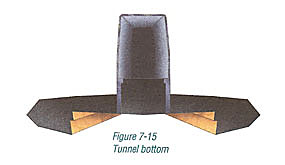
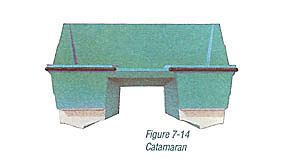 These hulls usually are vee bottoms with some degree of added outside hull, often most predominant near the bow (Figure 7-13). The benefit is a boat that is more stable, particularly at rest. The penalty is a rough ride in choppy water.
These hulls usually are vee bottoms with some degree of added outside hull, often most predominant near the bow (Figure 7-13). The benefit is a boat that is more stable, particularly at rest. The penalty is a rough ride in choppy water.
Tunnel Bottom
This design is most popular in racing circles. It differs from the older catamaran bottom (Figure 7-14) in that the inside corners (between the bottom and the tunnel) are quite sharp (Figure 7-15). This allows incredibly sharp high-speed turns and a very soft ride. Some of these hulls have experienced handling problems at low speeds.
Tunnel Vee
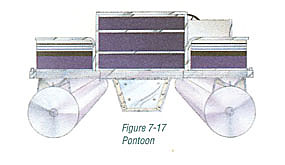
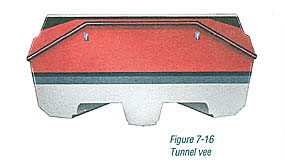 This combines a shallow vee bottom with twin tunnels (Figure 7-16), one on either side of a center pad. Top-end performance is usually superior to a true vee bottom, but this generally comes with a rougher ride in choppy water and does not carry a load as well as a conventional vee.
This combines a shallow vee bottom with twin tunnels (Figure 7-16), one on either side of a center pad. Top-end performance is usually superior to a true vee bottom, but this generally comes with a rougher ride in choppy water and does not carry a load as well as a conventional vee.
Pontoon
A pontoon is basically a flat surface floating on two or three pontoons (round or squarish), usually made of aluminum. This design maximizes a boat's usable space. Pontoons can easily be run at planing speeds, but the front ends must be properly shaped for planing (Figure 7-17).
Condition of the Boat Bottom

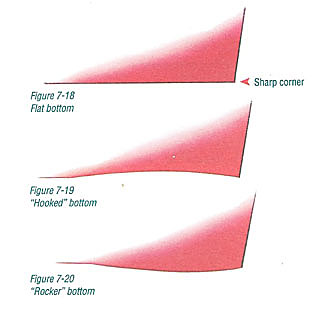 For maximum speed, a boat bottom should be as flat as possible in a fore-aft direction (longitudinally) for approximately the last five feet (1.5 m) (Figure 7-18). For best speed and minimum spray, the corner between the bottom and the transom should be sharp.
For maximum speed, a boat bottom should be as flat as possible in a fore-aft direction (longitudinally) for approximately the last five feet (1.5 m) (Figure 7-18). For best speed and minimum spray, the corner between the bottom and the transom should be sharp.
The bottom is referred to as having a "hook" if it is concave in the fore-and-aft direction (Figure 7-19). A hook causes more lift on the bottom near the transom and forces the bow to drop. This increases wetted surface and reduces boat speed, but it helps planing and reduces any porpoising (rhythmical bouncing) tendency. A slight hook is often built in by the manufacturer. A hook can also be caused by not trailering or storing the boat with support directly under the transom.
A "rocker" is the reverse of a hook (Figure 7-20). The bottom is convex or bulged in the fore-and-aft direction. It can cause the boat to porpoise.
Any hook, rocker, or surface roughness on the bottom, particularly in the all-important center-aft portion (critical bottom area) (Figure 7-21), will have a negative effect on speed, often costing several miles per hour on a fast boat.
Single-Engine & Multiple-Engine Application
In single-engine installations, right-hand rotation propellers are almost always used. This is merely the result of tradition, but is perpetuated by nearly all recreational boat manufacturers placing their operator's position on the right-hand side to compensate for the boat roll resulting from a right-hand rotation propeller.
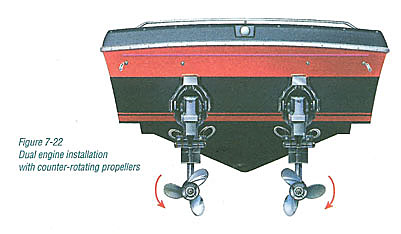 When a boat is equipped with dual engines, counter-rotating propellers are preferred (Figure 7-22). This balances any steering pull when the outboards or drives are trimmed evenly. Most experienced boaters prefer to rotate the propellers "out." That is, right-hand rotation on the right side, left-hand rotation on the left side, believing that overall handling is a little better. This can also afford more balanced steering when forced to operate with only one (off-center) engine. Many twin engine boats use propellers of the same rotation. The disadvantages are that steering torque is greater when trimmed well in or well out (assuming no power steering) and, in very rough water, if a hull goes airborne, a pair of right-hand propellers (for example) can walk the stern to the right a little.
When a boat is equipped with dual engines, counter-rotating propellers are preferred (Figure 7-22). This balances any steering pull when the outboards or drives are trimmed evenly. Most experienced boaters prefer to rotate the propellers "out." That is, right-hand rotation on the right side, left-hand rotation on the left side, believing that overall handling is a little better. This can also afford more balanced steering when forced to operate with only one (off-center) engine. Many twin engine boats use propellers of the same rotation. The disadvantages are that steering torque is greater when trimmed well in or well out (assuming no power steering) and, in very rough water, if a hull goes airborne, a pair of right-hand propellers (for example) can walk the stern to the right a little.
